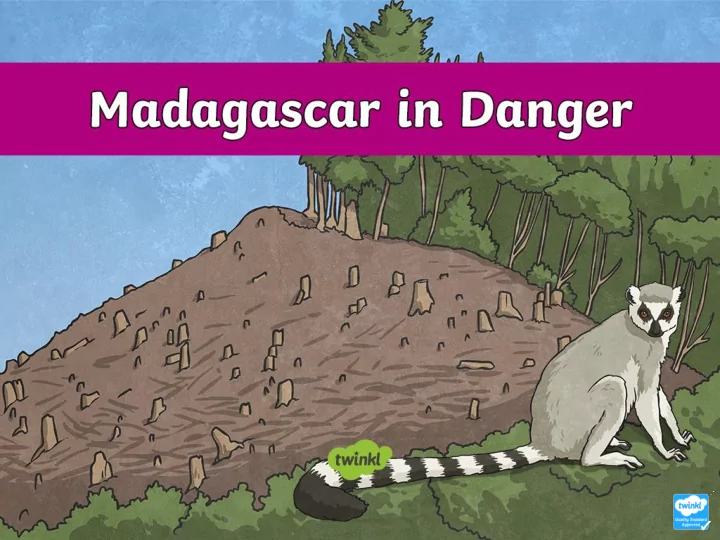

Madagascar Map of the World Madagascar is here in red.
Madagascar Madagascar is an island that lies approximately 400km off the south-east coast of Africa. This island formed around 160 million years ago, and is the fourth largest island in the world. Madagascar has several different landscapes and geographical areas. Where are the tropical forests in Madagascar? What is the beige area like?
Madagascar Madagascar has been an island for many millions of years. The plants and animals found in the forests of Madagascar have evolved and changed differently from living things on other land masses such as Africa or India. This means that Madagascar is home to many plants and animals that are found nowhere else on Earth. As many as 90% of the living things on Madagascar are thought to be endemic - this means that they are unique to Madagascar.
Madagascar These species of plants and animals are only found on Madagascar. Grandidier’s Darwin's orchid baobab tree aye-aye fossa panther chameleon lemur
Conservation Unfortunately, many of the plants and animals that live on Madagascar are becoming endangered. This means that they are at risk of becoming extinct. Some scientists and conservationists have set up conservation areas to try to save these animals. A conservationist is a person who works to protect and care for the environment and living things. Gerald Durrell was a conservationist who worked hard to save Madagascar's unique plants and animals. But what dangers do the living things on Madagascar face?
Deforestation Many people who live in Madagascar rely on farming for their food and their livelihood. In order to make space for fields, people cut down the trees in the tropical forests. This is known as deforestation. The people use a technique called 'slash and burn'. First, trees are cut down for wood use. Small trees are planted in their place. A few years later, these trees are cut down to make charcoal. The next year, the plot of land is burned, and a crop of grass is planted.
Deforestation What dangers do you think this method of deforestation poses for the living things in Madagascar's forests?
Investigating Dangers You are going to investigate the effects of deforestation. You will set up your investigation by following the instructions on your Investigating Deforestation Activity Sheet.
Explaining Dangers • The water in the bucket from Bottle A is clear. The plants and their roots hold the soil in place so it does not drain away. • The water in the bucket from Bottle B is slightly dirtier. The layer of twigs and leaves helps to keep most of the soil in place. • The water in the bucket from Bottle C is very dirty and full of soil. There is nothing to hold it in place so it drains away easily. .
Explaining Dangers When the trees of Madagascar's forests are cut down and burnt, this causes the soil to drain away into rivers and lakes when it rains. This is called soil erosion. Nutrients in the soil are washed away too, so any soil left behind is very poor and plants and trees will not grow back. This is leading to something called desertification in Madagascar. This means that the areas of the rainforest that are deforested will not grow back, and are turning into deserts. The animals and plants that live in the forests of I’m hungry. Madagascar will have no habitat and no food to eat. They are in danger of dying out. Around 20 species of animals in Madagascar, including lemurs, are critically endangered. This means that these species are in imminent danger of extinction.
Gerald Durrell and Conservation • Gerald Durrell was born in India in 1925, and was an English conservationist. • He worked hard to conserve the endangered species of Madagascar. • Gerald Durrell founded the Durrell Wildlife Trust and the Jersey Zoo, which is now called the Durrell Wildlife Park. • He set up his own zoo in 1959 especially to look after endangered animals from around the world. . • He made several expeditions all over the world to find endangered animals and bring them back to his Wildlife Park in Jersey, where he cared for them and set up breeding programmes so that these species could successfully have young. .
Gerald Durrell and Conservation Once Gerald had a base for his animals and his work, he founded the Durrell Wildlife Conservation Trust to run international conservation programmes. He also opened a training centre at the Wildlife Park, to teach scientists about conservation. Over a thousand biologists and conservationists have attended training at the Durrell Training Institute. In 1990, the Durrell Wildlife Trust established their conservation programme in Madagascar.
Gerald Durrell and Conservation After Gerald Durrell's death in 1995, the Durrell Trust continued to work in Madagascar, and the Durrell Conservation programme in Madagascar is now the Trust's largest programme in the world. The Durrell Trust runs eight main conservation sites in Madagascar, and they work with local people to develop more sustainable farming methods. The Durrell Trust focuses on the most endangered species on the island, including the aye-aye, lemurs, the angonoka tortoise and the Madagascar pochard (a species of duck).
Recommend
More recommend